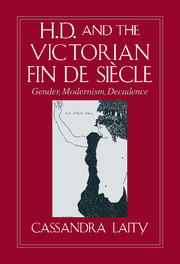Book contents
- Frontmatter
- Contents
- Acknowledgments
- Introduction: Dramatis Personae: The Aesthete Androgyne and the Femme Fatale
- 1 The Rhetoric of Anti-Romanticism: Gendered Genealogies of Male Modernism
- 2 H.D.'s Early Decadent Masks and Images: HER; Sea Garden
- The Aesthete Androgyne
- The Femme Fatale
- 5 Toward a Revised Myth of Origins: From the Diaphanous Androgyne to the Abject Femme Fatale
- 6 From Agon to “Héros Fatale”: Pre-Raphaelite Transformations of Male Modernism/Modernity
- 7 Feminine Abjection and Trilogy
- Postscript
- Notes
- Index
- CAMBRIDGE STUDIES IN AMERICAN LITERATURE AND CULTURE
5 - Toward a Revised Myth of Origins: From the Diaphanous Androgyne to the Abject Femme Fatale
Published online by Cambridge University Press: 06 January 2010
- Frontmatter
- Contents
- Acknowledgments
- Introduction: Dramatis Personae: The Aesthete Androgyne and the Femme Fatale
- 1 The Rhetoric of Anti-Romanticism: Gendered Genealogies of Male Modernism
- 2 H.D.'s Early Decadent Masks and Images: HER; Sea Garden
- The Aesthete Androgyne
- The Femme Fatale
- 5 Toward a Revised Myth of Origins: From the Diaphanous Androgyne to the Abject Femme Fatale
- 6 From Agon to “Héros Fatale”: Pre-Raphaelite Transformations of Male Modernism/Modernity
- 7 Feminine Abjection and Trilogy
- Postscript
- Notes
- Index
- CAMBRIDGE STUDIES IN AMERICAN LITERATURE AND CULTURE
Summary
By the early 1930s, H.D. was suffering from the writing block that would baffle her for nearly a decade. Susan Friedman theorizes that H.D.'s aesthetic of androgyny, twinship, and bisexual desire reached a figurative dead end in Nights (1931), where H.D. expressed her “death wish” through the chilling suicide of her heroine – the female half of the novel's androgynous pairing (PW 218). Hiding behind the male mask and unable to fiilly reconcile her “two loves separate,” H.D. came to associate bisexuality, as Friedman notes, with “being cast out of a ‘home’ category,” and androgyny with “living in limbo – neither man nor woman” (PW 310). Perhaps not incidentally, H.D.'s chief Romantic mask of boy androgyny through the 1920s – Swinburne's Hermaphroditus – now formed an ironic commentary on the gender impasse of H.D.'s male masking. Unlike its celebratory brother poem (“Fragoletta”), “Hermaphroditus” is a distressed ode on androgyny as sexual “indifference”:
Love stands upon thy left hand and thy right,
Yet by no sunset and by no moonrise
Shall make thee man and ease a woman's sighs,
Or make thee woman for a man's delight.
(P&B I, 90)H.D. could no longer find a fluid, androgynous space between boy Aesthete and mother muse, but remained caught in the “limbo” of their mutual negation. Clearly, by the early 1930s, the play had gone out of H.D.'s Decadent Romantic revisionism. Several critics have focused on the ways in which H.D.'s analysis with Freud (1933, 1934) began the process of selfcreation that would allow for the more woman-centered mythos of the later poetry.
- Type
- Chapter
- Information
- H. D. and the Victorian Fin de SiècleGender, Modernism, Decadence, pp. 115 - 149Publisher: Cambridge University PressPrint publication year: 1996



